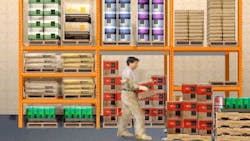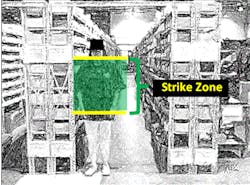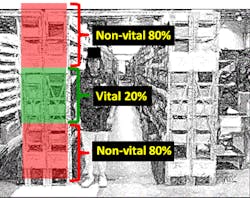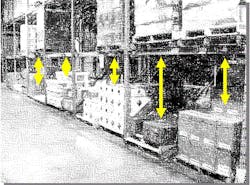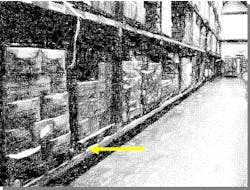Warehouse Ergonomics: The Vital Few Versus the Trivial Many
In 1906 the Italian engineer, sociologist, economist, political scientist and philosopher Vilfredo Pareto offered a mathematical assertion to explain the disparity of wealth distribution in his country. Pareto observed that 20% of the people owned 80% of the wealth.
In 1941 Dr. Joseph M. Juran, a management consultant who is principally remembered for his work in quality and quality management, stumbled across the work of Pareto and began to assert widely the Pareto Principle to quality issues. (For example, 80% of a problem is caused by 20% of the issues.) This was also known as "the vital few and the trivial many."1
In later years, Juran recoined the Pareto Principle as the 80/20 Rule. The 80/20 Rule means that in anything a few (20%) are vital and many (80%) are trivial. In Juran's initial work, he identified 20% of the defects causing 80% of the problems. Project managers know that 20% of the work consumes 80% of time and resources.
You can apply the 80/20 Rule to almost anything in life. For example, 20% percent of the drivers on the roads are the source of 80% of the problems, 20% of the clothes in one’s closet are worn 80% of the time, or 20% of a restaurant’s menu is 80% of the sales.
In warehousing, every warehouse, every distribution center and every storage area has ‘high movers’ and ‘high velocity’ products -- items that move faster and in higher volume than others. As the 80/20 Rule suggests, 20% of the product in a warehouse or storage area is picked 80% of the time. Likewise, 20% of the warehouse stock consumes 80% of the warehouse space. In most distribution centers, warehouses and general storage areas, these 80/20 Rules are truisms.
What in the world does the 80/20 Rule have to do with warehouse ergonomics, you ask? It is simple. Throughout every warehouse in the world, there are shelves that are used for storage. Shelves can range from a few feet high to high-rack systems that can soar to 30 feet to 50 feet. If companies can identify their high movers from a pick history list, the “vital” 20% can be optimally located within the shelving systems to maximize production efficiencies and to minimize wasted time and effort. The 80/20 Rule can help companies strategically locate “vital” materials so that employees’ efficiency and safety are maximized.
Warehousing Concerns
Warehouses (and distribution centers) are common operations throughout the world. Some warehouses are completely automated, but the vast majority are still non-automated and require stock and product to be handled manually by the employees.
According to the Occupational Safety and Health Administration (OSHA), there are more than 145,000 employees who work in over 7,000 warehouses throughout the United States. Besides sudden acute accidental injuries, chronic injuries caused by repetitive motion and awkward postures occur as well and can be just as serious. These injuries are quietly the "big money" claims for many warehousing and distribution companies.
Over the years, the National Institute for Occupational Safety and Health (NIOSH) has conducted several key studies to evaluate the risks and job demands associated with warehousing:
- Metabolic rate studies: - Conducted a research study evaluating the potential for injury to warehouse workers and found that the mean metabolic rates, as measured by oxygen consumption, were above recommended limits for young male workers during an eight-hour workday.2
- Biomechanical studies: - Lumbar movements in typical warehouse tasks, as analyzed and measured in terms of flexionangle of the trunk and lateral and twisting velocity, combined with the lifting rate and other factors, indicated a high risk of lower back injury.2
- Time-motion analyses: - NIOSH's collected data indicated that the average frequency of lifts during normal activities of the selectors was 4.1 lifts per minute. This lifting rate and the average load of 30.4 pounds that NIOSH observed would probably result in fatigued muscles, especially since a high percentage (53%) of the lifts required extreme trunk flexion and reaches above the height of the shoulder, according toNIOSH.2 In layman's terms, motion experts say that order selectors are particularly vulnerable to chronic muscle strain and fatigue injuries. Not only do these workers continually lift heavy loads and frequently use an extended field of motion, but they also work under severe time restraints, which causes employees to put extra pressure on muscles due to the lack of proper recovery time between lifts.2
Employees suffer injuries that range from shoulders, elbows, wrists, hands and backs, with backs accounting for the vast majority of the injuries. Every time an employee picks an item, whether large or small, they use their hands, wrists and arms. These picks are the source for the hands grasping shut thousands of times each workshift. Depending on where the item is located, the shoulders and backs may be brought into play. Finally, if pulling and pushing are involved, then the elbows are engaged.
Correctly Position Vital Job Demands
In an industry where tens of thousands of parts are manually handled each day, it is critical for employers to understand how to optimize their most critical process -- the employees’ ability to lift and handle product safely and efficiently. When manual material handling is the primary physical demand of the job and these activities are the driving force behind developing injuries in warehousing -- and if working outside the ‘strike zone’ is the primary biomechanical risk for generating injuries -- the focus of warehousing companies should be to design the workplace so that the ‘vital’ job demands are correctly positioned to maximize the employees’ capabilities. In others words -- let the 80/20 Rule determine which items will be located within the strike zone.
The Strike Zone
When manual material handling is such a vital element in the daily operations of a company, it is only reasonable to assume that companies will want to optimize this process. When ergonomists analyze manual lifting tasks, they regularly refer to a zone that is optimal for lifting, handling and carrying material. To use a baseball metaphor, it commonly is called the “strike zone.” The strike zone is the zone between the shoulders and the knuckle height of a person, when standing. (See Photo 1)
In this zone, the employee can move his or her hands freely without too much biomechanical strain. If a person reaches below their knuckles (the lower limit of the strike zone), they are required to flex the hips (bend forward at the waist) in order to reach downward. Handling material below knuckle-height forces poor postures (bending over) and increases handling time (one study found that working below knuckle-height took 3.2 times as long to perform work as working in the “strike-zone”). If they are required to reach above the shoulders (the upper limit of the strike zone), then the shoulders are required to abduct to perform the task. Back flexions and shoulder abductions are directly associated with increased risk of low back and shoulder injuries and illnesses, respectively.
When manual material handling is such a vital element in the daily operations of a company, it is only reasonable to assume that companies will want to optimize this process. When ergonomists analyze manual lifting tasks, they regularly refer to a zone that is optimal for lifting, handling and carrying material. To use a baseball metaphor, it commonly is called the “strike zone.” The strike zone is the zone between the shoulders and the knuckle height of a person, when standing. (See Photo 1)
As far as a design strategy goes, if products, material and tasks can be positioned within the strike zone so that employees can minimize out-of-the-strike-zone reaches and tasks, then the employees’ postures will be optimized, productivity will be improved and the risks of back and shoulder injuries will be reduced.
Shelving Design
The general rule of thumb for shelf design is that manually handled product should be stored between shoulder height and knuckle height -- the “strike zone.” The strike zone is a convenient location for work and material placement because it maximizes efficiency and can reduce the potential injuries associated with reaching and awkward postures.
However, from a business/production standpoint, limiting shelves to the strike zone is not the best utilization of floor space, and in order to maximize storage space, it should be expected that shelving will exceed shoulder height level. If it is to be expected that shelving will customarily exceed the preferred strike zone, at least there can be an organized effort to minimize the negative effects of reaching outside the strike zone. The plan should be to store heavier and high-use items within the strike zone and store lighter and low-use items in the bin locations that are not. This will reduce the weight and frequency component of these less-than- desirable lifts. (See Photo 2)
High Rack Systems
The goal in every high rack system should be to place the “high movers” down low. This minimizes climbing on ladders, saves time and is an excellent way to control the risks of falls. (See Photo 3)
Product that is located high in the racks requires the use of ladders or equipment to retrieve. Retrieving parts while climbing ladders or on equipment generates wasteful travel time, and climbing increases the risk of human falls, product drops and severe injuries.
Intuitively, the scenario shown in Photo 3 conflicts with the ‘below knuckle’ height rules discussed earlier. Although the risk of falling is reduced, employees may continue to be exposed to the risk of bending over, when retrieving product. There is yet another product positioning strategy that can improve this condition.
Many times, lower bins are filled with pallets that, when fully loaded, do not completely fill the space within the bin. There is open vertical space above the top of the loaded pallet. (See Photo 4)
If pallets can be raised within the bin so that the open, vertical space above the product can be minimized, this will elevate more of the product into the preferred strike zone. This can be accomplished by installing additional shelf bar just above the floor. (See Photo 5)
Not all pallets will be a candidate for this strategy, but where possible it can reduce the amount of below-knuckle height lifts experienced by the employees.
Conclusion
The value of the 80/20 Rule for a warehouse operation is that it reminds an organization to focus on the 20% that matters. Of the gazillion things that warehouses and distribution centers handle, the vital 20% matters most. Those 20 percent produce 80% of your results. In the case of the worker, the results are the number of times they must handle product. Designing the warehouse with the vital 20% in mind (highest frequency and heaviest items) will greatly benefit the employees.
Identify and focus on these specific items. If these items can be positioned or presented to the employees within their working “strike zones,” they cannot help but be more efficient and have a safer outcome.
Lance S. Perry, PE, CPE, is senior ergonomist/professional engineer with Zurich Services Corp.
References
1) Reh, J., “Pareto's Principle - The 80-20 Rule” How the 80/20 rule can help you be more effective, http://management.about.com/cs/generalmanagement/a/Pareto081202.htm
2) Baron, S., Putz-Anderson, V., Waters, T., HETA 93-0920-2548 NIOSH Investigators, Ergonomic: Kroger Grocery Warehouse, December 1995, http://www.cdc.gov/niosh/hhe/reports/pdfs/1993-0920-2548.pdf
